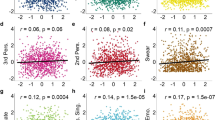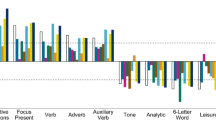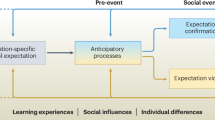Abstract
Depression is a leading cause of disability worldwide, but is often underdiagnosed and undertreated. Cognitive behavioural therapy holds that individuals with depression exhibit distorted modes of thinking, that is, cognitive distortions, that can negatively affect their emotions and motivation. Here, we show that the language of individuals with a self-reported diagnosis of depression on social media is characterized by higher levels of distorted thinking compared with a random sample. This effect is specific to the distorted nature of the expression and cannot be explained by the presence of specific topics, sentiment or first-person pronouns. This study identifies online language patterns that are indicative of depression-related distorted thinking. We caution that any future applications of this research should carefully consider ethical and data privacy issues.
This is a preview of subscription content, access via your institution
Access options
Access Nature and 54 other Nature Portfolio journals
Get Nature+, our best-value online-access subscription
$32.99 / 30 days
cancel any time
Subscribe to this journal
Receive 12 digital issues and online access to articles
$119.00 per year
only $9.92 per issue
Buy this article
- Purchase on SpringerLink
- Instant access to full article PDF
Prices may be subject to local taxes which are calculated during checkout



Similar content being viewed by others
Data availability
All data used in this study are available in deidentified form in a dedicated and open GitHub repository (https://github.com/mctenthij/CDS_paper). Any additional information with respect to the data used in this study will be made available from the corresponding author upon reasonable request, provided this information can be made available in deidentified form. Any additional data and information are available from the corresponding author on reasonable request.
Code availability
The code and related data of this study are freely available at GitHub (https://github.com/mctenthij/CDS_paper) enabling reproduction.
References
Greenberg, P. E., Fournier, A.-A., Sisitsky, T., Pike, C. T. & Kessler, R. C. The economic burden of adults with major depressive disorder in the United States (2005 and 2010). J. Clin. Psychiatry 76, 155–162 (2015).
World Health Organization. Depression and Other Common Mental Disorders: Global Health Estimates (World Health Organization, 2017).
Case, A. & Deaton, A. Rising morbidity and mortality in midlife among white non-Hispanic Americans in the 21st century. Proc. Natl Acad. Sci. USA 112, 15078–15083 (2015).
Mojtabai, R., Olfson, M. & Han, B. National trends in the prevalence and treatment of depression in adolescents and young adults. Pediatrics 138, e20161878 (2016).
Mitchell, A. J., Vaze, A. & Rao, S. Clinical diagnosis of depression in primary care: a meta-analysis. Lancet 374, 609–619 (2009).
Wang, P. S. et al. Twelve-month use of mental health services in the United States: results from the National Comorbidity Survey replication. Arch. Gen. Psychiatry 62, 629–640 (2005).
Hofmann, S. G., Asnaani, A., Vonk, I. J., Sawyer, A. T. & Fang, A. The efficacy of cognitive behavioral therapy: a review of meta-analyses. Cognit. Ther. Res. 36, 427–440 (2012).
Cuijpers, P. et al. Does cognitive behaviour therapy have an enduring effect that is superior to keeping patients on continuation pharmacotherapy? A meta-analysis. BMJ Open 3, e002542 (2013).
Lorenzo-Luaces, L., German, R. E. & DeRubeis, R. J. It’s complicated: the relation between cognitive change procedures, cognitive change, and symptom change in cognitive therapy for depression. Clin. Psychol. Rev. 41, 3–15 (2015).
Ozdel, K. et al. Measuring cognitive errors using the cognitive distortions scale (CDS): psychometric properties in clinical and non-clinical samples. PloS ONE 9, e105956 (2014).
Beck, A. T. & Haigh, E. A. Advances in cognitive theory and therapy: the generic cognitive model. Annu. Rev. Clin. Psychol. 10, 1–24 (2014).
Clark, D. A. & Beck, A. T. Cognitive theory and therapy of anxiety and depression: convergence with neurobiological findings. Trends Cognit. Sci. 14, 418–424 (2010).
Foland-Ross, L. C. & Gotlib, I. H. Cognitive and neural aspects of information processing in major depressive disorder: an integrative perspective. Front. Psychol. 3, 489 (2012).
van de Leemput, I. A. et al. Critical slowing down as early warning for the onset and termination of depression. Proc. Natl Acad. Sci. USA 111, 87–92 (2014).
Webb, T. L., Miles, E. & Sheeran, P. Dealing with feeling: a meta-analysis of the effectiveness of strategies derived from the process model of emotion regulation. Psychol. Bull. 138, 775–808 (2012).
Fan, R. et al. The minute-scale dynamics of online emotions reveal the effects of affect labeling. Nat. Hum. Behav. 3, 92–100 (2019).
DeRubeis, R. J., Siegle, G. J. & Hollon, S. D. Cognitive therapy versus medication for depression: treatment outcomes and neural mechanisms. Nat. Rev. Neurosci. 9, 788–796 (2008).
Troy, A. S., Wilhelm, F. H., Shallcross, A. J. & Mauss, I. B. Seeing the silver lining: cognitive reappraisal ability moderates the relationship between stress and depressive symptoms. Emotion 10, 783–795 (2010).
Rude, S., Gortner, E.-M. & Pennebaker, J. Language use of depressed and depression-vulnerable college students. Cogn. Emot. 18, 1121–1133 (2004).
Tackman, A. M. et al. Depression, negative emotionality, and self-referential language: a multi-lab, multi-measure, and multi-language-task research synthesis. J. Pers. Soc. Psychol. 116, 817–834 (2019).
Coppersmith, G., Dredze, M., Harman, C. & Hollingshead, K. From ADHD to SAD: analyzing the language of mental health on Twitter through self-reported diagnoses. In Proc. 2nd Workshop on Computational Linguistics and Clinical Psychology: From Linguistic Signal to Clinical Reality, CLPsych (eds Mitchell, M., Coppersmith, G. & Hollingshead, K.) 1–10 (Association for Computational Linguistics, 2015).
Bernard, J. D., Baddeley, J. L., Rodriguez, B. F. & Burke, P. A. Depression, language, and affect: an examination of the influence of baseline depression and affect induction on language. J. Lang. Soc. Psychol. 35, 317–326 (2016).
Smirnova, D. et al. Language patterns discriminate mild depression from normal sadness and euthymic state. Front. Psychiatry 9, 105 (2018).
Zimmermann, J., Brockmeyer, T., Hunn, M., Schauenburg, H. & Wolf, M. First-person pronoun use in spoken language as a predictor of future depressive symptoms: preliminary evidence from a clinical sample of depressed patients. Clin. Psychol. Psychother. 24, 384–391 (2017).
Cacheda, F., Fernandez, D., Novoa, F. J. & Carneiro, V. Early detection of depression: social network analysis and random forest techniques. J. Med. Internet Res. 21, e12554 (2019).
Cavazos-Rehg, P. A. et al. A content analysis of depression-related tweets. Comput. Hum. Behav. 54, 351–357 (2016).
Al-Mosaiwi, M. & Johnstone, T. In an absolute state: elevated use of absolutist words is a marker specific to anxiety, depression, and suicidal ideation. Clin. Psychol. Sci. 6, 529–542 (2018).
Eichstaedt, J. C. et al. Facebook language predicts depression in medical records. Proc. Natl Acad. Sci. USA 115, 11203–11208 (2018).
Choudhury, M. D., Gamon, M., Counts, S. & Horvitz, E. Predicting depression via social media. In Proc. Seventh International AAAI Conference on Weblogs and Social Media, ICWSM (eds Emre Kiciman, E., Ellison, N. B., Hogan, B., Resnick, P. & Soboroff, I.) 128–137 (2013).
Reece, A. G. et al. Forecasting the onset and course of mental illness with Twitter data. Sci. Rep. 7, 13006 (2017).
Coppersmith, G., Dredze, M. & Harman, C. Quantifying mental health signals in Twitter. In Proc. Workshop on Computational Linguistics and Clinical Psychology: From Linguistic Signal to Clinical Reality, CLPsych (eds Resnik, P., Resnik, R. & Mitchell, M.) 51–60 (Association for Computational Linguistics, 2014).
Hasin, D. S. et al. Epidemiology of adult DSM-5 major depressive disorder and its specifiers in the United States. JAMA Psychiatry 75, 336–346 (2018).
Rnic, K., Dozois, D. J. & Martin, R. A. Cognitive distortions, humor styles, and depression. Eur. J. Psycholol. 12, 348–362 (2016).
Fiske, A., Wetherell, J. L. & Gatz, M. Depression in older adults. Ann. Rev. Clin. Psychol. 5, 363–389 (2009).
Wang, Z. et al. Demographic inference and representative population estimates from multilingual social media data. In Proc. 2019 World Wide Web Conference, WWW (eds Liu, L. & White, R.) 2056–2067 (Association for Computing Machinery, 2019).
Albert, P. R. Why is depression more prevalent in women? J. Psychiatry Neurosci. 40, 219–221 (2015).
Kuehner, C. Why is depression more common among women than among men? Lancet Psychiatry 4, 146–158 (2017).
Chancellor, S., Birnbaum, M. L., Caine, E. D., Silenzio, V. M. B. & De Choudhury, M. A taxonomy of ethical tensions in inferring mental health states from social media. In Proc. Conference on Fairness, Accountability, and Transparency, FAT (eds Boyd, D. & Morgenstern, J.) 79–88 (Association for Computing Machinery, 2019).
Benton, A., Coppersmith, G. & Dredze, M. Ethical research protocols for social media health research. In Proc. First ACL Workshop on Ethics in Natural Language Processing, EthNLP (eds Hovy, D. et al) 94–102 (Association for Computational Linguistics, 2017).
Molendijk, M. L. et al. Word use of outpatients with a personality disorder and concurrent or previous major depressive disorder. Behav. Res. Ther. 48, 44–51 (2010).
Fast, L. A. & Funder, D. C. Gender differences in the correlates of self-referent word use: authority, entitlement, and depressive symptoms. J. Pers. 78, 313–338 (2010).
Al-Mosaiwi, M. & Johnstone, T. In an absolute state: elevated use of absolutist words is a marker specific to anxiety, depression, and suicidal ideation. Clin. Psychol. Sci. 6, 529–542 (2018).
Brockmeyer, T. et al. Me, myself, and I: self-referent word use as an indicator of self-focused attention in relation to depression and anxiety. Front. Psychol. 6, 1564 (2015).
Ingram, R. E. Self-focused attention in clinical disorders: review and a conceptual model. Psychol. Bull. 107, 156–176 (1990).
Hutto, C. J. & Gilbert, E. VADER: a parsimonious rule-based model for sentiment analysis of social media text. In Proc. Eighth International AAAI Conference on Weblogs and Social Media, ICWSM (eds Adar, E. & Resnick, P.) (Association for Computing Machinery, 2014).
Ribeiro, F. N., Araújo, M., Gonçalves, P., Gonçalves, M. A. & Benevenuto, F. Sentibench—a benchmark comparison of state-of-the-practice sentiment analysis methods. EPJ Data Sci. 5, 23 (2016).
Dodds, P. S. et al. Human language reveals a universal positivity bias. Proc. Natl Acad. Sci. USA 112, 2389–2394 (2015).
Ewbank, M. P. et al. Quantifying the association between psychotherapy content and clinical outcomes using deep learning. JAMA Psychiatry 77, 35–43 (2019).
Morris, R. R., Schueller, S. M. & Picard, R. W. Efficacy of a web-based, crowdsourced peer-to-peer cognitive reappraisal platform for depression: randomized controlled trial. J. Med. Internet Res. 17, e72 (2015).
Kazdin, A. E. & Blase, S. L. Rebooting psychotherapy research and practice to reduce the burden of mental illness. Perspect. Psychol. Sci. 6, 21–37 (2011).
Lin, L. Y. et al. Association between social media use and depression among U.S. young adults. Depress. Anxiety 33, 323–331 (2016).
Keles, B., McCrae, N. & Grealish, A. A systematic review: the influence of social media on depression, anxiety and psychological distress in adolescents. Int. J. Adolesc. Youth 25, 79–93 (2020).
Kelly, Y., Zilanawala, A., Booker, C. & Sacker, A. Social media use and adolescent mental health: findings from the UK Millennium Cohort Study. EClinicalScience 6, 59–68 (2018).
Kalimeri, K., Beiro, M. G., Bonanomi, A., Rosina, A. & Cattuto, C. Traditional versus Facebook-based surveys: evaluation of biases in self-reported demographic and psychometric information. Demogr. Res. 42, 133–148 (2020).
McKee, R. Ethical issues in using social media for health and health care research. Health Pol. 110, 298–301 (2013).
Pratap, A. et al. Contemporary views of research participant willingness to participate and share digital data in biomedical research. JAMA Netw. Open 2, e1915717 (2019).
Davis, C. A. et al. OSoMe: the IUNI observatory on social media. PeerJ Comput. Sci. 2, e87 (2016).
Ernala, S. K. et al. Methodological gaps in predicting mental health states from social media: triangulating diagnostic signals. In Proc. 2019 CHI Conference on Human Factors in Computing Systems (eds Brewster, S. & Fitzpatrick, G.) 134 (Association for Computing Machinery, 2019).
Chancellor, S. & Choudhury, M. D. Methods in predictive techniques for mental health status on social media: a critical review. npj Digit. Med. 3, 43 (2020).
Kamphuis, M. H. et al. Does recognition of depression in primary care affect outcome? The PREDICT-NL study. Fam. Pract. 29, 16–23 (2011).
Ruscio, A. M. Normal versus pathological mood: implications for diagnosis. Ann. Rev. Clin. Psychol. 15, 179–205 (2019).
Beck, A. T. Thinking and depression: I. Idiosyncratic content and cognitive distortions. Arch. Gen. Psychiatry 9, 324–333 (1963).
Beck, A. T. Thinking and depression: II. Theory and therapy. Arch. Gen. Psychiatry 10, 561–571 (1964).
Burns, D. The Feeling Good Handbook (Harper-Collins Publishers, 1989).
Beck, J. S. & Beck, A. T. Cognitive Therapy: Basics and Beyond (Guilford Press, 1995).
Acknowledgements
We thank L. M. Rocha for his feedback on the general methodology and terminology, as well as K. Dobson, R. DeRubeis, C. Webb, S. Hoffman, N. Kazantzis, J. Garber and R. Jarrett for their feedback on the content of our list of CDS. J.B. thanks NSF grant SMA/SME1636636, COVID-19 funding from IU’s Office of the Vice President for Research, The Urban Mental Health institute at the University of Amsterdam, Wageningen University and Research, and the ISI Foundation for their support. The funders had no role in study design, data collection and analysis, decision to publish or preparation of the manuscript.
Author information
Authors and Affiliations
Contributions
M.t.T. and J.B. conceptualized the analysis; M.t.T. and J.B. designed the methodology; L.A.R., L.L.-L. and J.B. constructed the CDS lexicon; K.C.B. and M.t.T. constructed the datasets; K.C.B., M.t.T. and J.B. performed data analysis; and K.C.B., M.t.T., L.A.R., L.L.-L. and J.B. wrote the manuscript.
Corresponding author
Ethics declarations
Competing interests
L.L.-L. received an honorarium for consulting from Happify, Inc. in September 2020. Happify, Inc. creates behavioural change technologies (for example, apps) for mental health. Happify had no role in study design, data collection and analysis, decision to publish or preparation of the manuscript. The remaining authors declare no competing interests.
Additional information
Peer review information Nature Human Behaviour thanks Glen Coppersmith, Christopher Danforth and David Dozois for their contribution to the peer review of this work. Primary Handling Editor: Jamie Horder.
Publisher’s note Springer Nature remains neutral with regard to jurisdictional claims in published maps and institutional affiliations.
Supplementary information
Supplementary Information
Supplementary Figs. 1–4, Supplementary Tables 1–4, and an overview of exact CDS, the time-matched control and the control for the presence of hyperlinks.
Rights and permissions
About this article
Cite this article
Bathina, K.C., ten Thij, M., Lorenzo-Luaces, L. et al. Individuals with depression express more distorted thinking on social media. Nat Hum Behav 5, 458–466 (2021). https://doi.org/10.1038/s41562-021-01050-7
Received:
Accepted:
Published:
Issue date:
DOI: https://doi.org/10.1038/s41562-021-01050-7
This article is cited by
-
Major depressive disorder recognition based on electronic handwriting recorded in psychological tasks
BMC Medicine (2025)
-
Cognitive distortions are associated with increasing political polarization
Communications Psychology (2025)
-
Anxiety and Depression are Associated with More Distorted Thinking on Social Media: A Longitudinal Multi-Method Study
Cognitive Therapy and Research (2025)
-
Depression Symptoms are Associated with Frequency of Cognitive Distortions in Psychotherapy Transcripts
Cognitive Therapy and Research (2025)
-
Integrating clinical anxiety scales with pre-trained language models for anxiety recognition on social media
Health Information Science and Systems (2025)



